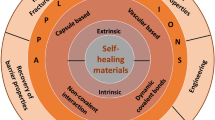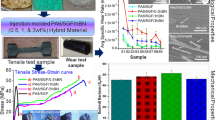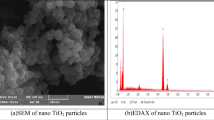Abstract
Osteolysis caused by wear particles from polyethylene in the artificial hip joints is a serious issue. In order to endow the low friction and wear of the bearing surface of ultra-high molecular weight polyethylene (UHMWPE) artificial joint for a longer term, hydrophilic acrylic acid (AA) was grafted on UHMWPE powders with the method of ultraviolet irradiation and then the modified powders were hot pressed. The tribological properties of modified UHMWPE sliding against CoCrMo metallic plate on reciprocating tribometer under calf serum, saline and distilled water lubrication during a long-term friction were investigated. The measurement of Fourier-transform infrared spectroscopy indicates that AA is successfully grafted on the surface of UHMWPE powders by photo-induced graft polymerization. Contact angles of UHMWPE are decreased from 83° to 35° by grafting and the surface wettability is effectively improved. The tensile strength of modified sample decreases. The friction coefficient and wear rate of UHMWPE-g-PAA under calf serum, saline and distilled water lubrication are lower than that of untreated UHMWPE. With the increase of grafting ratio, the wear rate of UHMWPE-g-PAA decreases firstly and then increases. The modified UHMWPE with grafting ratio of 3.5 % has the lowest wear rate, which is just quarter of the untreated UHMWPE. The hydrated PAA polymer brushes enclosed in the UHMWPE bulk material provide continuous lubrication during long term sliding.








Similar content being viewed by others
References
Glant TT, Jacobs JJ, Molnár G, Shanbhag AS, Valyon M, Galante JO. Bone resorption activity of particulate-stimulated macrophages. J Bone Miner Res. 1993;8(9):1071–9.
Klein J. Molecular mechanisms of synovial joint lubrication. Proc Inst Mech Eng Part J. 2006;220(8):691–710.
Katta J, Jin Z, Ingham E, Fisher J. Biotribology of articular cartilage—a review of the recent advances. Med Eng Phys. 2008;30(10):1349–63.
Sheiko SS, Sumerlin BS, Matyjaszewski K. Cylindrical molecular brushes: synthesis, characterization. Prog Polym Sci. 2008;33(7):759–85.
Klein J. Repair or replacement a joint perspective. Science. 2009;323(5910):47–8.
Moro T, Takatori Y, Ishihara K, et al. Surface grafting of artificial joints with a biocompatible polymer for preventing periprosthetic. Nature Mater. 2004;3(11):829–36.
Kyomoto M, Moro T, Miyaji F, et al. Effect of 2-methacryloyloxyethyl phosphorylcholine concentration on photo-induced graft polymerization of polyethylene in reducing the wear of orthopaedic bearing surface. J Biomed Mater Res Part A. 2008;86(2):439–47.
Kyomoto M, Moro T, Konno T, et al. Enhanced wear resistance of modified cross-linked polyethylene by grafting with poly(2-methacryloyloxyethyl phosphorylcholine). J Biomed Mater Res Part A. 2007;82(1):10–7.
Kyomoto M, Moro T, Miyaji F, et al. Enhanced wear resistance of orthopaedic bearing due to the cross-linking of poly(MPC) graft chains induced by gamma-ray irradiation. J Biomed Mater Res Part B. 2008;84B(2):320–7.
Kyomoto M, Moro T, Takatori Y, Kawaguchi H, Ishihara K. Cartilage-mimicking, high-density brush structure improves wear resistance of crosslinked polyethylene: a pilot study. Clin Orthop Relat Res. 2011;469(8):2327–36.
Qiu Y, Park K. Environment-sensitive hydrogels for drug delivery. Adv Drug Deliv Rev. 2001;53(3):321–39.
Yessine MA, Leroux JC. Membrane-destabilizing polyanions: interaction with lipid bilayer and endosomal escape of biomacromolecules. Adv Drug Deliv Rev. 2004;56(7):999–1021.
Jabbari E, Nozari S. Swell behavior of acrylic acid hydrogels prepared by γ-radiation crosslinking of polyacrylic acid in aqueous solution. Eur Polym J. 2000;36(12):2685–92.
Ulbricht M, Riedel M. Ultrafiltration membrane surfaces with grafted polymer ‘tentacles’: preparation, characterization and application for covalent protein binding. Biomaterials. 1998;19(14):1229–37.
Vasilets V, Hermel G, König U, et al. Microwave CO2 plasma-initiated vapour phase graft polymetization of acrylic acid onto polytetrafluoroethylene for immobilization of human thrombomodulin. Biomaterials. 1997;18(17):1139–45.
De Giglio E, Cometa S, Cioffi N, Torsi L, Sabbatini L. Analytical investigations of poly (acrylic acid) coatings electrodeposited on titanium-based implants: a versatile approach to biocompatibility enhancement. Anal Bioanal Chem. 2007;389(7):2055–63.
De Giglio E, Cafagna D, Ricci M, et al. Biocompatibility of poly(acrylic acid) thin coating elecrosynthesized onto TiAlV-based implants. J Bioactive Compatible Polym. 2010;25(4):374–91.
Kobayashi M, Yamaguchi H, Terayama Y, et al. Structure and Surface properties of high-density polyelectrolyte brushes at the interface of aqueous solution. Macromol Symp. 2009;279(1):79–87.
ISO 15989. Plastic-film and sheeting-measurement of water-contact angle of corona treated films. 2004.
Sobieraj MC, Kurtz SM, Wang A, Manley MM, Rimnac CM. Notched stress–strain behavior of a conventional and a sequentially annealed highly crosslinked UHMWPE. Biomaterials. 2008;29(35):4575–83.
ISO 527-1, B. Plastics—determination of tensile properties, part 1. 1994.
ISO 527-2, E. Determination of tensile properties—part 2: test conditions for moulding and extrusion plastics. 1996.
ISO 14242-1, E. Implants for surgery—wear of total hip-joint prostheses. Part 1. 2002.
ISO 14242-2, E. Implants for surgery—wear of total hip joint prostheses—part 2. 2002.
Zhao B, Brittain WJ. Polymer brushes: surface-immobilized macromolecules. Prog Polym Sci. 2000;25(5):677–710.
Briscoe WH, Titmuss S, Tiberg F, Thomas RK, McGillivray DJ, Klein J. Boundary lubrication under water. Nature. 2006;444(7116):191–4.
Wang A, Sun D, Stark C, Dumbleton J. Wear testing based on unidirectional motion: fact or artifact. Proceedings of the 5th World Biomaterials Congress. Toronto: University of Toronto Press; 1996.
Wang A, Polineni V, Essner A, et al. The significance of nonlinear motion in the wear screening of orthopaedic implant materials. J Test Eval. 1997;25(2):239–45.
Wang A, Lee R, Herrera L, Korduba L. Wear of ultra-high molecular weight polyethylene moving along a circular path in a hip simulator. Wear. 2013;301(1–2):157–61.
Acknowledgments
The authors wish to express thanks to the financial support of the National Natural Science Foundation of China (Grant No. 50975145, 11172142).
Author information
Authors and Affiliations
Corresponding author
Rights and permissions
About this article
Cite this article
Deng, Y., Xiong, D. & Wang, K. Biotribological properties of UHMWPE grafted with AA under lubrication as artificial joint. J Mater Sci: Mater Med 24, 2085–2091 (2013). https://doi.org/10.1007/s10856-013-4970-x
Received:
Accepted:
Published:
Issue Date:
DOI: https://doi.org/10.1007/s10856-013-4970-x




